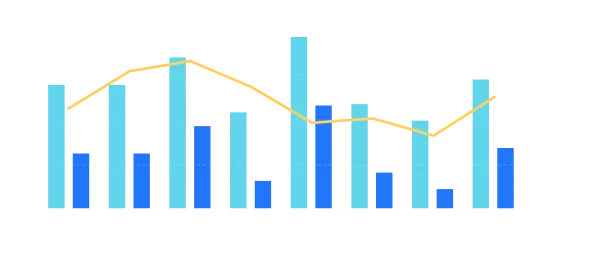

Trading (or trade) is the process of buying and selling financial instruments for profit. The main assets for trading include:
shares in a company that can be bought and sold on stock markets
currency trading where you earn on the difference in exchange rates
digital currencies such as Bitcoin and Ethereum.
collections of stocks of large companies, such as the S&P 500 index
oil, gold, silver and other natural resources
Trading can be profitable, but it also involves risk. It is important to understand how to analyze the market, manage risks, and control your emotions.
To make informed decisions, traders use two main types of analysis:
Analyzes price charts and uses various indicators (e.g. moving averages, RSI, MACD) to predict future market movements. This is an ideal approach for short-term traders looking for entry and exit points.
On the charts you can see the historical price movement, and candlesticks show how the price has changed over a certain period of time.
These are mathematical calculations that help predict future price movement. Some popular indicators include moving averages, RSI, and MACD.




This is the analysis of economic data, news and events that may affect prices. For example, changes in interest rates, company reports or political news.
It is important to monitor global events that may impact the market, such as changes in economic policy, natural disasters or geopolitical instability.
Here are some key features you need to familiarize yourself with:
Displays price movements. You can customize the chart type (line, bar, candlestick) depending on your preferences
You can always check what trades were opened, closed and what profit or loss was made.
To buy or sell an asset, you need to place an order. The most popular types of orders are:
Market order: buy or sell at the current market price.
Limit order: order to buy or sell at a certain price.
Stop loss: order to limit losses if the price goes in an unfavorable direction for you.

After registering on the Nexium Markets platform and opening a demo account, you can start testing your knowledge without risk. This will help you get used to the platform interface, learn how to analyze charts and make decisions. Here are a few steps to get started:
start using the platform easily and quickly, without complicated procedures and risks

You can select one or more assets (such as stocks, currencies or cryptocurrencies) to start trading.

For beginners, a simple strategy will do, such as trading with the trend or using basic indicators

Use stop loss and take profit to limit losses and lock in profits
One of the most important aspects of successful trading is the ability to manage risks. Here are some tips to help you minimize potential losses:
This will help you survive in the market even with a series of unsuccessful trades.
High leverage can lead to big losses if the market moves against you
Always place a stop loss order
Trading is a marathon, not a sprint. Patience and discipline are the keys to success

Emotions can greatly influence your decisions, and this is one of the main reasons why traders lose money. Here are some psychological aspects to consider:
These emotions often cause traders to make impulsive decisions. Fear can prevent you from acting at the right moment, and greed can make you risk too much
It is important to stick to your trading strategy and not deviate from your plan due to emotions.
Don't trade if you feel tired or unsure. Emotional state affects decision making
Remember that success in trading is the result of training, practice and discipline. Use our demo account to practice, monitor the market and develop your skills

